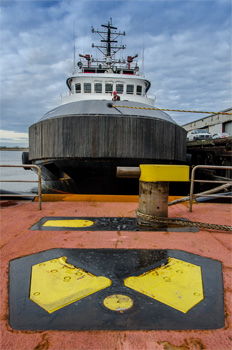The crew of Crowley Maritime’s tug Ocean Wave, just returned from two weeks at sea, were regrouping at their home port in Lake Charles, La. The Ocean-class tug was contracted to deliver reel pipe barges to Heerema Marine Contractor’s deepwater construction vessel, Aegir, laying pipeline for the Anadarko Lucius spar rig in the Gulf of Mexico.
Ocean Wave, delivered in September 2012, was the first of four powerful tugs constructed at Bollinger Shipyards in an ambitious building program by Crowley.
 |
|
Capt. Ward Davis on watch at the 146-foot tug’s forward control station. |
“You have to remember that at the time we started building these boats, the market was down and we didn’t have the work secured,” said John Ara, vice president of Crowley Solutions. “However, we had a good selection of shipyards.”
It appears the risky venture has paid off. Ocean Wave has participated in two rescue operations, one a containership aground on the north shore of Cuba, and another, the Shell rig Kulluk, run aground in Alaska. In consort with class mates Ocean Wind , Ocean Sky and Ocean Sun, the tug c onducted rig tows in the Gulf.
The Crowley quartet features dynamic positioning capabilities more common to supply vessels. Wave and Wind are DP-1 t ugs, and Sky and Sun are DP-2. “These DP tugs respond and han dle really well,” said Ca pt. Ward Davis on Ocean Wave. “And there are not many DP tugs out there.”
“The hull design facilitates making up in a push mode, alongside or on the tow wire,” said Ara.
 |
|
One pair of Ocean Wave’s Caterpillar C280-12 Tier II main engines, which together generate 10,880 bhp. Above, chief engineer Bill Dubay monitors the performance.
|
He added that the variable-pitch propellers and rudders that operate in consort or independently allow for a great deal of control. “That allows us to work in tight quarters or near-shore and the boat’s lower-profile house allows us to get in to closer proximity. The DP capability has made these tugs part of the installation evolution offshore.”
The engine room is a maze of machinery, piping and conduit enveloping two Caterpillar C280-12, Tier II diesels with Reintjes LAF 5666 reduction gears turning 154-inch CP propellers. The mains are soft-mounted in consideration of the crew’s comfort. To that end, there is an inch of insulation forming a floating floor between the engine room and the superstructure. All of that power produces 165 tons of bollard pull and a top speed of 16 knots.
“The winch is an obvious benefit,” said Davis. The custom-built Intercon 600-hp hydraulic DW275 double-drum waterfall towing winch has a pulling power of 500,000 pounds. The drums are reversed, placing the towing drum below the second drum, to increase the vessel’s stability. The 4,200 feet of 2.75-inch wire is under wound to place the towing wire closer to the aft deck, for a straighter vertical lineup with the Triplex shark jaws and towing pins.
“The layout and the living conditions aboard are very nice and they’re good-looking boats,” said Davis. The tugs are double-hulled and designed to prevent any overboard discharges of fuel or fluids. They carry an IMO Green Passport.
The Ocean-class tugs are armed with an International Load Line certificate, A-1 towing, FiFi-1, and ABS and SOLAS certification, combined with DP and all that towing power and equipment.
 |
 |
|
Ocean Wave’s Triplex 200-ton retractable towing pin is utilized to moor the tug. In the foreground are retracted Triplex 350-ton shark jaws. |
Able seaman Orvin McCoy, left, takes a mooring line from ordinary seaman Earnest Paulk, with able seaman Ferrel Bodden behind him. |
 |
 |
|
The three men handle a port-side mooring line. |
Mustering on deck are Dubay, able seaman Adam Middleton, assistant engineer Matt Coogan, assistant engineer Andrew Clarke, Davis, McCoy, Bodden and Paulk. |


